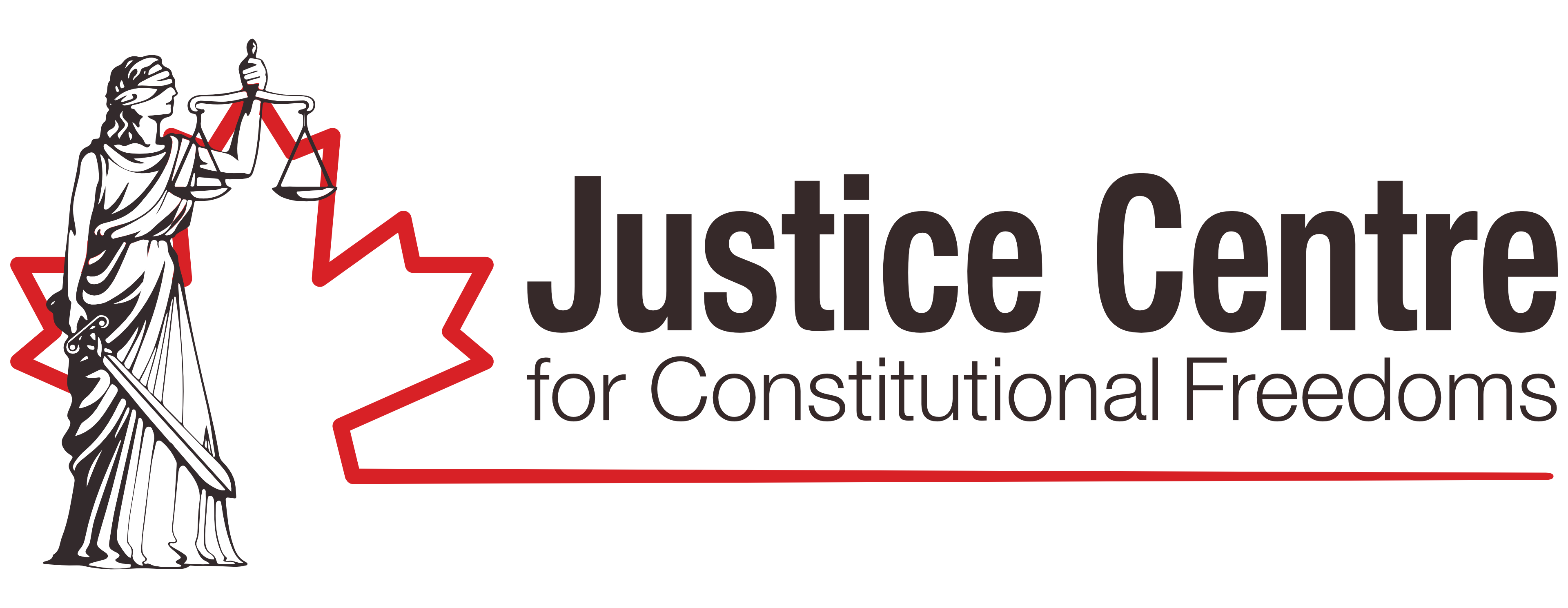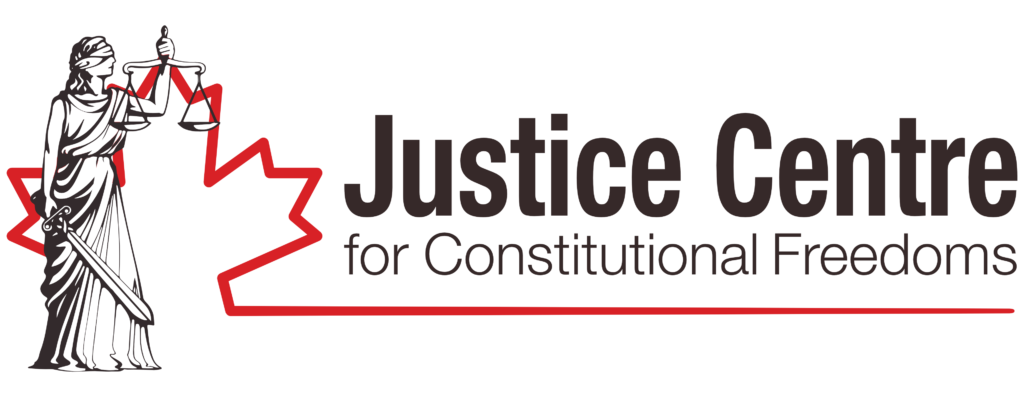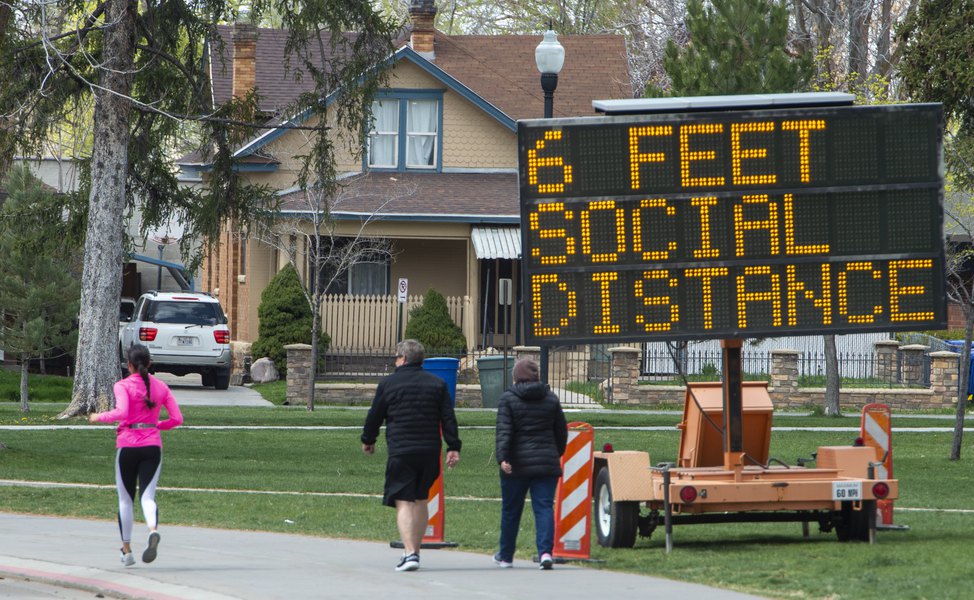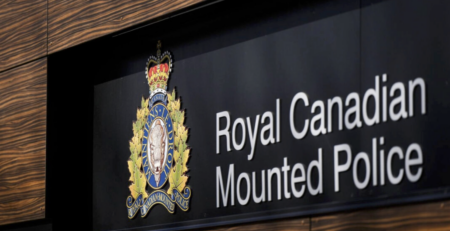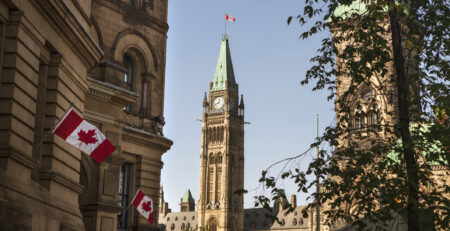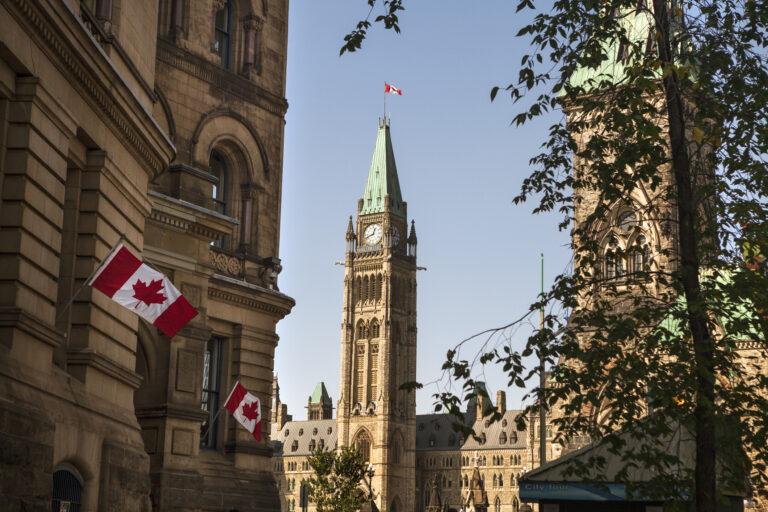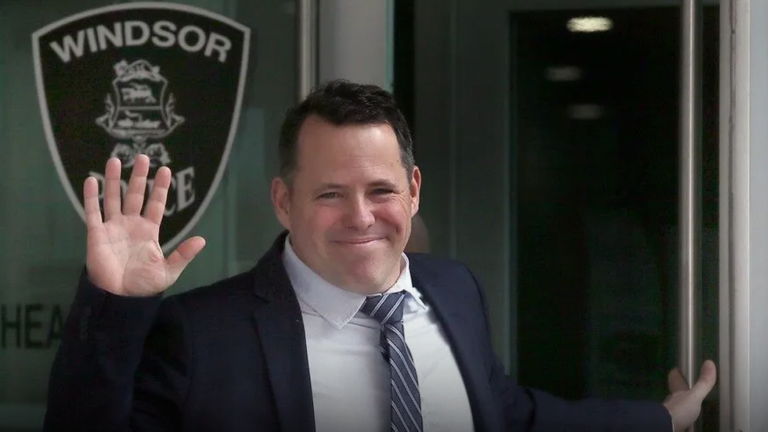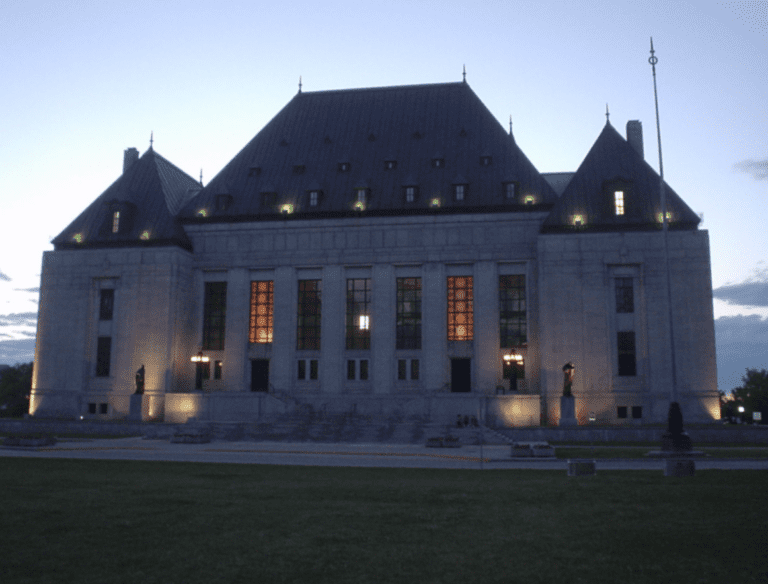Trial Update, Monday, April 4, 2022
The morning session began at 10:11 AM. Alberta Court of Queen’s Bench Justice Barbara Romaine presiding. Government lawyer Nicholas Parker advised the judge that the witness Dr. Deena Hinshaw had a meeting scheduled for 3:30 PM Wednesday, and asked that the court be mindful of this, requesting that they attempt to wrap up by 3 PM on April 6. Applicant lawyer Jeffery Rath responded that this would have to be revisited on that day because it was not possible to commit at this time. Justice Romaine accepted this.
Dr. Deena Hinshaw was then sworn in, and applicant lawyer for the Justice Centre for Constitutional Freedoms, Leighton Grey, began cross examination.
He first asked about an affidavit filed by Dr. Hinshaw in December 2020, in response to an injunction application. Dr. Hinshaw and Justice Romaine did not have a copy of that document. And so Mr. Grey said he would question Dr. Hinshaw on this later after she had a chance to review it.
Mr. Grey then questioned Dr. Hinshaw on her qualifications based on her CV, included with her affidavit. He asked if she agreed that her position was a political appointment. Dr. Hinshaw agreed but noted that the appropriate legislation had been changed to require those appointed to be specially trained in public health. Mr. Grey asked if she agreed that the role of the public health officer has been greatly expanded recently. Dr. Hinshaw disagreed and said her role was to provide advice to elected politicians who made the decisions. She would not agree that the power to issue province-wide public orders is new.
In response to Mr. Grey’s suggestion that he doesn’t recall there being a designated chief officer of health for the entire province until recently, Dr. Hinshaw said that this position has existed “for decades.” She stated that the position goes back a century to the creation of the first Alberta public Health Act. Mr. Grey then stated that it was his understanding that what was new in the legislation was the ability of the public health officer to use “any means necessary” to control an outbreak like the pandemic. Again, Dr. Hinshaw disagreed, saying “by-any-means-necessary predated the pandemic.” The two managed to agree that the way the public health orders were used during the recent pandemic is without precedent.
Mr. Grey then clarified areas where Dr. Hinshaw didn’t have any specialized training, including mental health, economics, education policy, religious policy, recreation policy, university and/or business policy, nor did she have any specialized training in travel or tourism. After this, Dr. Hinshaw agreed that her orders did impact all these areas.
With regards to expertise, Mr. Grey noted that Dr. Hinshaw is not an expert in virology or epidemiology, though she would often speak publicly about these issues. Dr. Hinshaw conceded she was not a expert, but considered herself competent in these subject. Many of her advisors were, however, experts.
With regard to harms caused by lockdowns, Dr. Hinshaw did agree there have been unintended consequences, but these had to be weighed against the benefits of certain Non-Pharmaceutical Interventions (NPIs).
Mr. Grey then turned to the “conceptual framework” around Dr. Hinshaw’s decisions, which are outlined in her affidavit. He focused on a statement that public health is based on concepts like social justice and health equity. He then stated that it looked to him like this was “socialism applied to healthcare” and asked if she agreed.
Mr. Parker objected at this point on the grounds of relevance. Mr. Grey responded that this policy guided that way the public health orders were created, and so is relevant to the Section 1 test Justice Romaine will have to consider.
Justice Romaine stepped in to clarify that Mr. Parker was objecting to the statement, “socialism applied to health care.” Justice Romaine supported the objection.
Mr. Grey then asked about the policy of health equity, noting in Dr. Hinshaw’s exhibits that it is stated that the poorest people have the poorest health outcomes. He said that in previous evidence, notably from Dr. Bhattacharya, expert witness for the applicants, that the poorest people were also the most negatively affected by Dr. Hinshaw’s lockdown orders, which didn’t seem all that equitable. Dr. Hinshaw did concede that “some of the (NPIs), not all of them” did impact the poor, but programs were put into place to try to deal with this. Also, to not intervene would have affected the poor greatly, so a choice had to be made.
Mr. Grey also referred to sections within the policy paper that addressed structural violence, intersectionality, with reference to quote from women’s right group. He then asked about the relevancy to health policy with regard to women’s rights and intersectionality. Dr. Hinshaw said that this footnote emphasizes that a person’s health is “impacted by the context within which they live.” She gave examples of indigenous people not being able to rent an apartment, or women not being able to work, as impacting their health. Mr. Grey then asked if women and indigenous people suffered greater impacts from COVID. Dr. Hinshaw said there was evidence that indigenous people were disproportionately impacted. And Mr. Grey said he did not see any orders of Dr. Hinshaw’s that dealt with these disparities. Dr. Hinshaw then referred to long-term care homes, which were disproportionately affected, and noted there were orders specifically dealing with these. Further, when vaccinations became available, priority was given to those in high-risk groups or situations, especially where there were limited supplies.
At 11:57 court took a 15-minute morning break.
Court resumed with Mr. Grey pointing out that Dr. Hinshaw in numerous press conferences had encourage people to make healthy lifestyle choices, but her health orders often contradicted this by limiting people’s ability to make those healthy choices, for instance, by closing gyms. This, he said, would be bad for the individual and society. Dr. Hinshaw replied that decisions were made looking at the big picture weighing the benefits and the risks of each intervention. Here she would introduce something that she would repeat a few times throughout the day; namely, the concept that harms to society are not limited to the virus, but how the virus impacted the health system; if the virus overwhelmed the health system, it would limit access for people who have other ailments or injuries.
She would also stress, several times throughout the day, that she readily admits there were harms caused by NPIs, but these had to be weighed against the risks and benefits to the whole population.
Mr. Grey also asked about other aspects included in Dr. Hinshaw’s affidavit, including a section on the social determinates of health, and Alberta’s Ethical Framework for dealing with the pandemic. He asked her for an example of a public health order of Dr. Hinshaw’s that would specifically disadvantage the poor. Dr. Hinshaw conceded that work from home policies would disadvantage those who could not transfer their jobs to an in-home situation, as they would be at a greater risk of infection. She said there were programs and policies that tried to mitigate these disadvantages, for instance, hotel accommodation programs.
Mr. Grey asked Dr. Hinshaw if in her interpretation, Alberta Health Services was outside of her jurisdiction when it came to using “any means necessary” to control the pandemic. Mr. Parker objected that this was calling for a legal interpretation. Mr. Grey responded that he was not asking for legal interpretation, but for Dr. Hinshaw’s understanding of her powers with regard to cancelled surgeries, hospital bed allocation, etc. Dr. Hinshaw clarified that her relationship with AHS was governed by the legislation, and this did not include things like resource allocation (i.e. hospital beds).
Mr. Grey moved on to a section in her affidavit that referred to AHS preparing a plan for the allocation of health services for a health region, and asked if she was aware of any such plan. Dr. Hinshaw said she believes that they had “numerous plans” but that she was not the best person to ask about this. And she referred to respondent witness Deb Gordon, from AHS, as the person who could answer this.
Then Mr. Grey discussed a proportionality principle referenced in the affidavit, and asked whether Dr. Hinshaw understood that, when she was issuing her orders, she would be restricting people’s liberties. She did. So then he asked at what point did she, and other government officials, start to consider bringing in the NPIs. Dr. Hinshaw replied that the first NPIs were brought in in March of 2020, and they were first discussed as they observed what was happening in international jurisdictions, New York and Italy, for example. Upon Mr. Grey pressing her, Dr. Hinshaw said the decision to use NPIs was made in March 2020. This was based on the speed with which those other jurisdictions appeared to go from a few cases to having their health care systems overwhelmed. In the second wave, she said, in the fall of 2020, the decision was made after several attempts at using voluntary measures failed to protect the hospital system and stop the spread. (Note: this reply with regard to the voluntary measures failing would be repeated in various forms throughout the day.)
Here Mr. Grey zeroed on this idea, asking whether it was that Albertans were not complying with the voluntary measures as the reason to move to mandatory policies. Dr. Hinshaw said yes, but the more important metrics were the case rates, hospitalizations, and so on, that climbed during the voluntary measures. Mr. Grey said that this was then an empirical analysis about the spread, but there was a subjective analysis was that this was caused by people failing to comply with recommended measures. Dr. Hinshaw countered that there was some evidence of complaints of non-compliance, and there was also the fact that in other provinces with mandatory policies they were not experiencing the same numbers as Alberta. But Mr. Grey pointed out that it is possible that the rise in cases in Alberta was not due to non-compliance. Dr. Hinshaw said she believes the evidence does not support that conclusion, to which Mr. Grey replied that she had said numerous times that this was a new virus that they were in the process of learning about.
In terms of specific NPIs, Mr. Grey stated that it is unknown whether masking works. Dr. Hinshaw then started to break down the types of masking studies done, for individuals, for society as a whole etc. She said it was important to “look at the totality of that evidence.” She believes, in her opinion, the evidence supports the use of masks as one NPI. Mr. Grey pointed out that she basically admitted that there is no scientific consensus about the effectiveness of masking. Here Dr. Hinshaw started qualifying her statement, referring to the beliefs of her colleagues that support her beliefs, indoor settings, broad consensus etc.
At 12:38 Justice Romaine called for lunch break.
After the break, questioning turned to various events covered by the mandatory orders. Mr. Grey pointed out in her affidavit, Dr. Hinshaw referred to choirs as being high risk, and he asked what this was based on. Dr. Hinshaw pointed out the risk factors, like opening their mouths at the same time, being close in a small space, etc. Group health activities would be another example of high risk of a super-spreader event.
Mr. Grey then went on to read several statements for her affidavit that used what he characterized as uncertain language, “suggests” “may cause” “can be” and that there appears to be “a declining level of certainty” in the scientific evidence presented as regards to social distancing.
Dr. Hinshaw stated that the orders restricting gatherings were based on the fact that there were several super-spreader events where over a hundred people fell ill, both locally and internationally. The orders were written to ensure that places of worship were not completely closed.
With regard to the restrictions on places of worship, Mr. Grey asked if the data in Dr. Hinshaw’s affidavit was the data used to make the decisions “that restricted liberty.” Dr. Hinshaw then stated the data used “was broader” that what was actually included in her affidavit.
Quoting directly from her affidavit, Mr. Grey noted that it stated “a small number of people were responsible for seeding a vast majority” of infections, and asked what evidence supported this. Dr. Hinshaw did not cite anything specific, but described generally the process of infection by respiratory particles in super-spreader events, and how this would move on to community infection.
Then Mr. Grey moved on to sections about asymptomatic spread, asking if it was rare. Dr. Hinshaw then went on to describe the difference between asymptomatic and pre-symptomatic spread, and eventually said that at that time, the evidence showed that asymptomatic spread was rare but that pre-symptomatic spread was more common. But Mr. Grey stated that the data indicated that even pre-symptomatic spread was not that common, and would not warrant the introduction of NPIs. Dr. Hinshaw disagreed with that, restating her position that pre-symptomatic spread “seems to be more significant.”
Mr. Grey zeroed in on the “seems to be” just stated, and asked if that was strong enough evidence to justify the NPIs. Dr. Hinshaw referred then to an exhibit that showed over 60% of spread occurred during the pre-symptomatic period. Mr. Grey noted this appeared to based on modelling. Dr. Hinshaw said that the PCR testing only found about 25% of infections and that follow-ups proved more fruitful in analyzing pre-symptomatic spread. She conceded that it was not always possible to find exactly when infection occurred. She emphasized, however, that modelling was an important aspect of analyzing asymptomatic and pre-symptomatic spread. Mr. Grey then rephrased the question by asking if a person with symptoms had a much higher chance of spreading the disease. Dr. Hinshaw agreed, though qualified this by saying that most of the transmission appeared to be due to pre-symptomatic and asymptomatic spread because those with symptoms were either asked, or required, to stay at home.
Mr. Grey noted that in the past, in dealing with infectious diseases, the focus has always been on quarantining the sick, those who had symptoms. He said that at some point there had to have been a decision not to go this route and he asked when the decision was made to go instead with “broad sweeping restrictions.” Dr. Hinshaw did not give a specific answer, but stated that the decision was made when it was observed that there was pre-symptomatic and asymptomatic transmission.
Mr. Grey then quoted a section where it stated that “many” people do not have serious outcomes from Covid, and he suggested that should probably say “most” instead of “many.” Dr. Hinshaw agreed with this, saying that 95% of those diagnosed do not require hospitalization, but qualified this by saying that we are still learning about post-Covid syndrome, so there may be many long-term affects unknown. Mr. Grey suggested that little is known about post-Covid syndrome at this point. Dr. Hinshaw said there is a lot that is unknown about “long Covid”, as it is known, and estimates of its prevalence are wide-ranging, as high as 20%. But Mr. Grey emphasized that the data showed that only about 4% of those diagnosed had severe symptoms. Dr. Hinshaw said this was the number that required hospitalizations, and this was the percentage before the introduction of vaccines.
Moving on to age and comorbidities, Mr. Grey read from the affidavit where it was noted that severe outcomes increased with age and “pre-existing conditions,” and Dr. Hinshaw agreed. He said that Dr. Bhattacharya had said in his testimony that this increase was by “orders of magnitude” and asked if she agreed. Dr. Hinshaw referred to data in her affidavit and said while it was true, there were some notable exceptions, where those under a year old had the same rates as those in their 30s. Mr. Grey then pointed out that there was a significant increase in hospitalizations and deaths in the age groups over 70 years, and that this proved that the Covid did not pose a significant risk to “the vast majority of Albertans.” Dr. Hinshaw said it would depend on the definition of “significant risk,” and Mr. Grey clarified that, according to the chart, it meant “hospitalizations, ICU admissions and deaths.” Dr. Hinshaw then qualified it again, saying that it would depend on what was being compared; if, for instance, this was being compared to influenza, then the risk for severe outcomes is much higher for Covid. Mr. Grey said he is not comparing it to anything. To him, the data showed that the risk of severe outcomes to the vast majority of Albertans was “vanishingly low.” Did she not agree?
Mr. Parker objected here, asserting that the question had been asked and answered. Mr. Grey replied that she provided part of answer. And he noted that Dr. Hinshaw had referenced the graph first, so he believed he should be allowed to ask her to interpret the data. Justice Romaine disagreed and supported the objection.
Moving on, Mr. Grey referred to another part of her affidavit, and pointed out that here it showed that deaths dropped off significantly under the age of 60 and asked if that was true. Dr. Hinshaw quoted the number of deaths to that point in those under 60 at 187. Mr. Grey then asked about under the age of 50, and suggested that deaths “dropped dramatically.” Dr. Hinshaw noted that with “each decade the risk decreases,” but reminded everyone that all lives matter.
Then the topic shifted to comorbidities, using Statistics Canada data Dr. Hinshaw cited in her affidavit. Mr. Grey quoted a section that stated that 90% of those who died of Covid in 2020 had one or more complication or comorbidity. Given this data, Mr. Grey suggested that “it didn’t make sense” to restrict most of the population in Alberta because the serious outcomes from Covid were limited to the elderly and those with comorbidities. Dr. Hinshaw disagreed. Mr. Grey brought up the example of smallpox, which once threatened a much younger population; this, he said, would justify NPIs because it affected everyone. Dr. Hinshaw was not sure whether the example of a more severe illness proved there was “insufficient justification” for the measures brought in to combat Covid. Mr. Grey then rephrased, saying that that Dr. Hinshaw’s public health orders affected all Albertans, even though 96% were not at risk for severe outcomes. Dr. Hinshaw said that all are affected if the hospital system is overwhelmed and access to other treatments was negatively impacted, and the situation would have been made worse if she had not intervened with NPIs. Mr. Grey referred, without citing specific examples, to studies that suggested that the impact of NPIs were negligible, and asked what she thought about these? Dr. Hinshaw went into the example of Alberta’s experience with wave 1 and 2 of Covid, how after the mandatory NPIs worked in wave 1; the voluntary measures in wave 2 failed, and then when the mandatory measures were brought back, they succeeded, implying that Alberta proved the effectiveness of NPIs.
Mr. Grey then turned to the comorbidity of obesity, quoting again from her affidavit, and asked if it was not true that most of the people hospitalized with Covid were obese. Dr. Hinshaw said that she didn’t know if that was true and cited a statistic that showed 1 in 5 hospital admissions had no comorbidities. But he did get Dr. Hinshaw to agree that obesity was a health risk factor for all conditions, including heart disease, hypertension and diabetes. There was some disagreement from Dr. Hinshaw on obesity being a main contributing factor for respiratory illness, stroke and cancer, etc. Though she acknowledged that these could contribute. She disagreed that obesity was a factor in immuno-deficiency disorders.
Mr. Grey then explained why he was asking about obesity. He said he had gone through all of Dr. Hinshaw’s public statements and press conferences, and he did not find one instance where she had advised Albertans about the risk of Covid due to obesity. Dr. Hinshaw thought she might have made a reference to it at some point, but couldn’t recall any specific statement. Mr. Grey asked if this omission was due to the sensitivity of the topic, not wanting to offend anyone. Dr. Hinshaw stated that it is wrong to consider obesity as simply of matter of will power, and besides, most of her health recommendations focused on what could be remedied in the short term.
At 2:53 PM court recessed for 15 minutes.
Resuming his cross examination, Mr. Grey referred back to Dr. Hinshaw’s statement about the success of the vaccine roll-out, which started with the vaccines being made available to high risk groups first. Dr. Hinshaw then described which groups received the vaccines and in what order, the elderly, those who worked with Covid patients, etc. Mr. Grey then suggested that this roll-out was an example of focused protection, which Dr. Bhattacharya had advocated. Did she not agree? She stated that she used the term “risk-based prioritization.” On the allocation of resources, she emphasized that the actual decisions are made by elected officials and she only provided recommendations. Mr. Grey said he understood her clarification, though he did note that to most of the province, she was the public face of the system dealing with the pandemic.
The topic then turned to the Great Barrington Declaration (GBD), a report that advocated focused-protection, with Mr. Grey suggesting that Dr. Hinshaw did not pay much attention to this. Dr. Hinshaw disagreed, stating that she had read it through, and provided a public rebuttal to it. Mr. Grey asked if she considered the GBD misinformation. Dr. Hinshaw referred to her public statement, where she wrote that the GBD was an appealing solution to those who were tired of restrictions, and those under 60, people who did not think through how the recommendations would actually be applied. She understood the GBD strategy as protecting the older population while having no restrictions on the younger population. She tried to envision how this would actually work, and judged it to be impractical. She believed that there would be significant mortalities among all age groups and an unmanageable burden on the healthcare system. But Mr. Grey suggested that this focused protection as advocated in the GBD was very similar to the way Alberta rolled out the vaccine program, in terms of allocating resources to the most vulnerable. So it seemed that Dr. Hinshaw was in less disagreement with the GBD than she stated, he said, and asked if she agreed. Dr. Hinshaw said the main difference between her approach and the GBD is that the GBD overestimated society’s ability to separate the different age groups.
Mr. Grey then turned to an affidavit section where Dr. Hinshaw described the team working with her. He asked if she had an epidemiologist on her team, and the reason for the question was due to the inclusion of Dr. Kindrachuk as a witness for the government, though he was from Manitoba. Dr. Hinshaw conceded that Dr. Kindrachuk was not on her team, but there were others who fulfilled that role. Mr. Grey noted that in the description of her team, there was no economist. He asked if there was anyone on her team who could provide a risk-benefit analysis of her public health orders, in terms of harms like business and job loss.
Dr. Hinshaw stated that when these issues arose, they would be referred to other ministries with more expertise on the subject. Mr. Grey asked if these ministries would report back to her with any analysis outlining economic harms of NPIs. Dr. Hinshaw, short answer, no; long answer, reported to cabinet committees that made the decisions etc. Asking for clarification, Mr. Grey then asked if she then did not consider economic harms when she made her health orders. Dr. Hinshaw took issue with the characterization that she was not concerned; she instead stated that she was not qualified to make those judgments. Mr. Grey then asked how this economic analysis would be included in the health orders, and Dr. Hinshaw referred to the process whereby the cabinet committee would help draft the public health orders after considering input to them.
Then Mr. Grey referenced Dr. Bhattacharya’s affidavit where it was stated there appeared to no consideration of economic impacts as NPIs were implemented in Alberta. As Mr. Grey understood it now, Dr. Hinshaw was stating there was no consideration of economic impacts by her, but this was done by others for her. Dr. Hinshaw didn’t like the characterization that it was done “for her” saying this was done for the elected officials who actually made the decisions. Her group did consider broad economic implications from a public health point of view, but not economic specifics.
Following up, Mr. Grey noted a sentence in her affidavit that stated that economic impacts were carefully weighed in this whole of government approach as NPIs were implemented. He asked if Dr. Hinshaw was aware of any specific study, a risk-benefit analysis, that dealt with these economic impacts of NPIs. Dr. Hinshaw was not sure there was “formalized report put together,” but they had provided analysis based on data from other jurisdictions, and other groups had created work based on some surveys. Pressing the point, Mr. Grey asked if she had seen, or was aware of, any comprehensive report on economic harms due to NPIs. Dr. Hinshaw said she believes that this was done “in more sector specific ways.” In other words, no.
Mr. Grey then asked if she has seen any reports that studied the impacts of school closure. She was aware of work that had been done in this area, particularly with regard to younger students. Mr. Grey asked if this was done before or after the school closures. Dr. Hinshaw said it was done after the 2020 spring closures, which is why they made efforts to keep schools open in subsequent waves. Mr. Grey asked if she had seen any Alberta studies done about the impacts of closure to businesses like gyms or restaurants before these were ordered closed. She said she was not personally aware of any, but she was certain there were. As far as her experts, they balanced etc. etc. Short answer, no. Mr. Grey suggested that in dealing with the balance, the weight was always given on the side of health, and not economic impacts. Dr. Hinshaw disagreed.
But Mr. Grey countered that it appeared the way things operated was that health decisions were made, knowing they would limit liberties, and after the fact when economic impacts surfaced, money was thrown at the problem. He asked her to respond. She restated that her approach after the first wave was to always opt for the “least intrusive” measures first, but that these did not work. She said there was no approach which would not cause some harm, and so her recommendations were for mandatory measures along with mitigating programs to deal with unintended consequences.
Mr. Grey said that it seemed that Alberta’s go-to response to Covid was always NPIs, that there seemed to be no questioning of this approach despite the lack of evidence to support it. He said there seemed to be no consideration of changing the approach to the type employed in Florida, for instance, or Sweden. He asked why this was. In a very long answer describing the course of the pandemic and its variants, Dr. Hinshaw first repeated that in waves 1 and 2, Alberta proved that NPIs worked.
The cycle of going in and out of lockdowns, Mr. Grey suggested, caused enormous harm to Albertans as it altered their ability to attend funerals, attend weddings or visit loved ones in hospitals. He asked Dr. Hinshaw if she understood this. Dr. Hinshaw stated that she always maintained that she accepted that the NPIs would cause harm and that she only used them as a last resort, when there was “no other option.” With regard to Sweden, she noted that early in the pandemic, that country had a death rate 12x higher than Alberta, and even though over the course of time, Alberta’s numbers have started to move up, there still was a 2x higher differential in the death rate. So there are trade-offs that had to be considered, and these are best left ultimately to elected officials.
Later, Mr. Grey pointed out that there is no data in her affidavit concerning long-Covid, and so it is very much an unknown. Dr. Hinshaw disagreed, saying “it is clearly a syndrome.” It is unknown at this time how many people who have had Covid will have “prolonged symptoms.”
In dealing with efforts to educate Albertans about Covid, Mr. Grey referred to an exhibit that stated that efforts were made by public health officials to inform the public about voluntary measures, but people would not take them seriously. He asked about the source for this. He also suggested that the interpretation of this was the blaming of the public for the failure of voluntary measures, and no consideration that perhaps the public health advice was simply not working. Dr. Hinshaw replied that once the voluntary measures became mandatory then the cases started to drop. Mr. Grey then quoted a section that stated that people take risks with their health, such as having unprotected sex. He asked if this was scientific justification for lockdowns, that people engage in high risk behaviour.
Mr. Grey said this sounded like blaming to him, talking down to Albertans. He asked if she agreed. Dr. Hinshaw said she understands that “perspective,” but it was a statement of fact. In the face of rapidly escalating cases, she reiterated that they had to achieve their goals of lowering the risk to the public and the health care system by moving to more restrictive methods.
Mr. Grey then brought up a report from AHS from 2020 that he said appeared to be show an effort to understand why people would not comply with public health orders. Dr. Hinshaw could not specifically recall the work. He focused on a portion that stated that public health messaging should focus on groups that had a high incidence of “non-adherence” to public health orders; this included men, conservatives and young people. He asked if she had seen this before. She said she may have, and that she has seen similar data supporting this. He asked if she thought this was discriminatory? Dr. Hinshaw again stated she has seen many surveys that support this, and that public health messaging should take into account an understanding of “where people are coming from” to change behaviour.
Mr. Grey then asked if she had focused her messaging targeting these groups. Dr. Hinshaw said they didn’t focus on these groups, but instead targeted leaders—faith leaders, business leaders, etc.–to urge them to make the public health arguments. Mr. Grey then scrolled down the document to a section that referred to something called a “Behaviour Change Wheel,” and he asserted that this sounded like behaviour modification, like mind control. Dr. Hinshaw said she was not familiar with the Behaviour Change Wheel, but it is important to remember that they were dealing with a significant health threat, and so it was important to everyone that they articulate the reasons for following public health measures. The public is subject to all kinds of marketing campaigns, and her group was focusing on letting people know how minimize their risk in the “least restrictive way.”
Justice Romaine interrupted stating she did not have a copy of the document being referenced. Mr. Parker said he didn’t believe they had a copy either. Mr. Grey had thought it had been sent, but he would double-check, and if not, would forward it on.
Court recessed until tomorrow, starting at 9:30 AM.
https://www.jccf.ca/court_cases/heights-baptist-church-northside-baptist-church-et-al-vs-alberta-and-the-chief-medical-officer-of-health/
